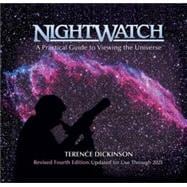
Note: Supplemental materials are not guaranteed with Rental or Used book purchases.
Purchase Benefits
What is included with this book?
Terence Dickinson is the best-selling author of 13 other astronomy books, including Backyard Astronomer's Guide and The Universe and Beyond. He has received many national and international science awards, including the New York Academy of Science Book of the Year Award.
| Discovering the Cosmos | p. 8 |
| Naturalists of the Night | |
| The Starry Realm | |
| The Universe in Eleven Steps | p. 12 |
| The Milky Way Galaxy | |
| Hubble Deep Field | |
| Backyard Astronomy | p. 26 |
| Sky Motions | |
| Sky Measures | |
| Big Dipper Signpost | |
| Star Brightness | |
| Constellations & Star Names | |
| Star & Constellation Pronunciation Guide | |
| Stars for All Seasons | p. 38 |
| The All-Sky Charts | |
| The Spring Sky | |
| The Summer Sky | |
| Urban Myths of Stargazing | |
| The Light-Pollution Factor | |
| The Autumn Sky | |
| The Winter Sky | |
| The Ecliptic & the Zodiac | |
| Stargazing Equipment | p. 60 |
| Selecting Binoculars | |
| Telescopes | |
| Frequently Asked Questions About Telescopes | |
| Telescope Types | |
| Computer-Age Scopes | |
| Accessories | |
| Eyepieces | |
| Factors to Consider When Selecting a First Telescope | |
| Probing the Depths | p. 82 |
| Double Stars | |
| Using Your Night Eyes | |
| Variable Stars | |
| Star Clusters | |
| Distances to Stars & Galaxies | |
| Nebulas | |
| Averted Vision | |
| Globular Clusters | |
| Galaxies | |
| Telescope Experience | |
| Designation of Sky Objects | |
| Atlas of 20 Star Charts | |
| The Planets | p. 120 |
| Astronomy From the City | |
| Mercury | |
| Venus | |
| Mars | |
| The Asteroid Belt | |
| Jupiter | |
| Saturn | |
| The Outer Planets | |
| Visibility of the Planets 2006-2018 | |
| Moon and Sun | p. 136 |
| Moon Maps | |
| Observing the Sun | |
| The Moon Illusion | |
| Solar and Lunar Eclipses | p. 146 |
| Observing Eclipses | |
| The Eclipse Cult | |
| Eclipse Tables | |
| Comets, Meteors and Auroras | p. 154 |
| Famous & Infamous Comets | |
| Meteors | |
| Auroras | |
| Photographing the Night Sky | p. 164 |
| Astro-Imaging Revolution | |
| Night-Sky Imaging Techniques | |
| The Barn-Door Tracker | |
| CCD Cameras | |
| Southern Hemisphere Night Sky | p. 172 |
| Southern Sky Charts | |
| Caribbean Night Sky | |
| Resources | p. 186 |
| Index | p. 190 |
| Table of Contents provided by Ingram. All Rights Reserved. |
The New copy of this book will include any supplemental materials advertised. Please check the title of the book to determine if it should include any access cards, study guides, lab manuals, CDs, etc.
The Used, Rental and eBook copies of this book are not guaranteed to include any supplemental materials. Typically, only the book itself is included. This is true even if the title states it includes any access cards, study guides, lab manuals, CDs, etc.